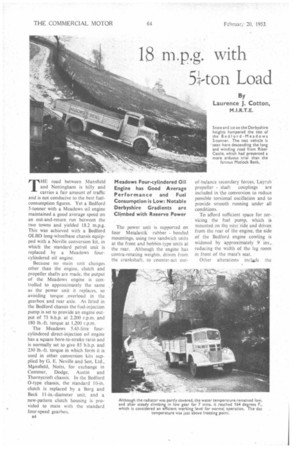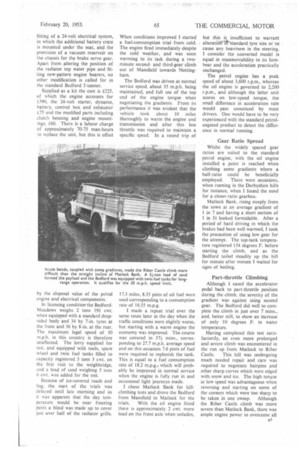18 m.p.g. with
Page 38

Page 39

Page 40

If you've noticed an error in this article please click here to report it so we can fix it.
511i-ton Load By Laurence J. Cotton,
.1.11.T.E.
THE road between Mansfield and Nottingham is hilly and carries a fair amount of traffic and is not conducive to the best fuelconsumption figures. Yet a Bedford 5-tonner with a Meadows oil engine maintained a good average speed on an out-and-return run between the two towns and yielded 18.2 m.p.g. This was achieved with a Bedford °LEM long-wheelbase chassis equipped with a Neville conversion kit, in which the standard petrol unit is replaced by a Meadows fourcylindered oil engine.
Because no main unit changes other than the engine, clutch and propeller shafts are made, the output of the Meadows engine is controlled to approximately the same as the power unit it replaces, so avoiding torque overload in the gearbox and rear axle. As fitted in the Bedford chassis the fuel-injection pump is set to provide an engine output of 73 b.h.p. at 2,200 r.p.m. and 180 lb.-ft. torque at 1,200 r.p.m.
The Meadows 5.43-litre fourcylindered direct-injection oil engine has a square bore-to-stroke ratio and is normally set to give 85 b.h.p. and 230 lb.-ft. torque in which form it is used in other conversion kits supplied by G. E. Neville and Son, Ltd., Mansfield, Notts, for exchange in Commer, Dodge, Austin and Thornycroft chassis. In the Bedford 0-type chassis, the standard 10-in. clutch is replaced by a Borg and Beck 11-in.-diameter unit, and a new-pattern clutch housing is provided to mate with the standard four-speed gearbox.
n4
The power unit is supported on four Metalastik rubber bonded mountings, using two sandwich units at the front and bobbin-type units at the rear. Although the engine has contra-rotating weights. driven from the crankshaft, to counter-act out
of-balance secondary forces, Layrub propeller shaft couplings are included in the conversion to reduce possible torsional oscillation and to provide smooth running under all conditions.
To afford sufficient space for servicing the fuel pump, which is mounted on the near side and driven from the rear of the engine, the side of the Bedford engine cowling is widened by approximately 9 ins., reducing the width of the leg room in front of the mate's seat.
Other alterations iric4de the
fitting of a 24-volt electrical system, in which the additional battery crate is mounted under the seat, and the provision of a vacuum reservoir on the chassis for the brake servo gear. Apart from altering the position of the radiator top water pipe and fitting new-pattern engine bearers, no other modification is called for in the standard Bedford 5-tonner.
Supplied as a kit the cost is £525, of which the engine accounts for £390, the 24-volt starter, dynamo, battery, control box and exhauster £75 and the modified parts including clutch housing and engine mountings, E60. There is a labour charge of approximately 70-75 man-hours to replace the unit, but this is offset by the disposal value of the petrol engine and electrical components.
In licensing condition' the BedfordMeadows weighs 2 tons 191 cwt. when equipped with a standard dropsided body and 34 by 7-in. tyres at the front and 36 by 8-in, at the rear. The maximum legal speed of 30 m.p.h. in this country is therefore unaffected. The lorry supplied for test, and equipped with tools, spare wheel and twin fuel tanks filled to capacity registered 3 tons 3 'cwt. on the first visit to the weighbridge, and a load of sand weighing 5 tons 6 cwt. was added for the test.
Because of ice-covered roads and fog, the start of the trials was delayed until late morning and as it was apparent that the day temperature would be near freezing point a blind was made up to cover just over half of the radiator grille. When conditions improved I started a fuel-consumption trial from cold. The engine fired immediately despite the cold weather, and was soon warming to its task during a twominute secondand third-gear climb out of Mansfield towards Nottingham.
The Bedford was driven at normal service speed, about 35 m.p.h. being maintained, and full use of the top end of the engine torque when negotiating the gradients. From its performance it was evident that the vehicle took about 10 miles thoroughly to warm the engine and transmission and after this less throttle was required to maintain a specific speed. In a round trip of 17.3 miles, 8.35 pints of oil fuel were used corresponding to a consumption rate of 16.55 m.p.g.
I made a repeat trial over the same route later in the day when the traffic conditions were slightly worse, but starting with a warm engine the economy was improved. The course was covered in 371 nuns., corresponding to 27.7 m.p.h. average speed and on this occasion 7.6 pints of fuel were required to replenish the tank. This is equal to a fuel consumption rate of 18.2 m.p.g.;which will probably be improved in normal service when the engine is fully run in and occasional light journeys made.
I chose Matlock Bank for hillclimbing tests and drove the Bedford from Mansfield to Matlock for the trials. With the oil engine fitted there is approximately 2 cwt. more load on the front axle when unladen, but this is insufficient to warrant alteratiOrthtandard tyre size or to cause any heaviness in the steering. I consider the converted model is equal in manceuvrability to its forebear and the acceleration practically unchanged.
The petrol engine has a peak speed of about 3,600 r.p.m., whereas the oil engine is governed to 2,200 r.p.m., and although the latter unit scores on low-speed torque, the small difference in acceleration rate would pass unnoticed by most drivers. One would have to be very experienced with the standard petrolengined product to detect the difference in normal running.
Gear Ratio Spread
Whilst the widely spaced gear ratiosare suited to the standard -petrol engine, with the oil engine installed a point is reached when climbing some gradients where a half-ratio could be beneficially employed. There were occasions, when running in the Derbyshire hills for instance, when I found the need for a closer-ratio gearbox.
Matlock Bank, rising steeply from the town at an average gradient of 1 in 7 and having a short section of 1 in 3+ looked formidable. After a period of hard driving in which the brakes had been well warmed, I took the precaution of using low gear for the attempt. The top-tank temperature registered 154 degrees F. before starting the climb, and as the Bedford toiled steadily up the hill for minute after minute I waited for signs of boiling.
Part-throttle Climbing Although I eased the accelerator pedal back to part-throttle position during the climb, the severity of the gradient was against using second gear. The Bedford did well to complete the climb in just over 7 mins., and, better still, to show an increase of only -10 degrees F. in water temperature.
Having completed this test satisfactorily, an even more prolonged and severe climb was encountered in the run up from Matlock to Riber Castle. This hill was undergoing much needed repair and care was required to negotiate hairpins and other sharp curves which were edged with snow and ice. The high torque at low speed was advantageous when reversing and starting on some of the corners which were too sharp to be taken in one sweep. Although the Riber Castle climb was more severe than Matlock Bank, there was ample engine power to overcome all
difficulties, and having reached the top without mishap, the Bedford was turned and driven back to Mansfield.
Only once before have I driven a vehicle equipped with the new Meadows 5.43-litre engine, and then I commented on its smooth running. Automatic advance, coupled with counter-balancing of the secondary forces, afford smoothness which makes it difficult to believe that there is only a four-cylindered engine under the bonnet, My one criticism of this unit is the heaviness of the accelerator pedal when overcoming the fuel-pump control at near maximum governed speed. In all other respects it is lively, economical and generally above average in its performance.
Sturdiness in design, coupled with long-life materials in the construction of the crankcase and bearings, should give to the Meadows engine a potential life at least equal to its contemporaries, including those governed to a lower maximum speed. The mounting brackets and rubbers supplied in the Bedford convecsion kit afford good balance of the power unit in the frame, and B6
apart from increased oscillation in comparison with a petrol engine at idling, I found no unusual movement of the gear lever or vibration in the cab during normal running.
In acceleration tests 30 m.p.h. was reached from rest in 29 secs., which is about 4 secsslower than the
petrol-engined equivalent carrying a comparable load. With :he return of fog in the early evening couPled with patches of ice on the road, I could make no further trials, but .n returning to Mansfield I noticed that the acceleration from 10 m.p.h. in top gear was quite smooth..




















































































